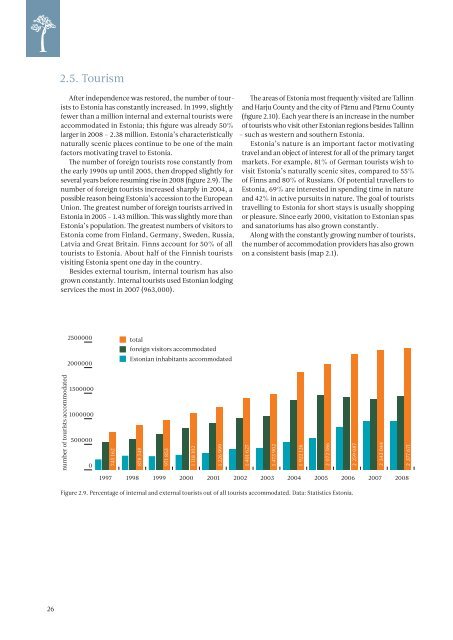ESTONIAN ENVIRONMENTAL REVIEW 2009
ESTONIAN ENVIRONMENTAL REVIEW 2009
ESTONIAN ENVIRONMENTAL REVIEW 2009
Create successful ePaper yourself
Turn your PDF publications into a flip-book with our unique Google optimized e-Paper software.
2.5. Tourism<br />
After independence was restored, the number of tourists<br />
to Estonia has constantly increased. In 1999, slightly<br />
fewer than a million internal and external tourists were<br />
accommodated in Estonia; this figure was already 50%<br />
larger in 2008 – 2.38 million. Estonia’s characteristically<br />
naturally scenic places continue to be one of the main<br />
factors motivating travel to Estonia.<br />
The number of foreign tourists rose constantly from<br />
the early 1990s up until 2005, then dropped slightly for<br />
several years before resuming rise in 2008 (figure 2.9). The<br />
number of foreign tourists increased sharply in 2004, a<br />
possible reason being Estonia’s accession to the European<br />
Union. The greatest number of foreign tourists arrived in<br />
Estonia in 2005 – 1.43 million. This was slightly more than<br />
Estonia’s population. The greatest numbers of visitors to<br />
Estonia come from Finland, Germany, Sweden, Russia,<br />
Latvia and Great Britain. Finns account for 50% of all<br />
tourists to Estonia. About half of the Finnish tourists<br />
visiting Estonia spent one day in the country.<br />
Besides external tourism, internal tourism has also<br />
grown constantly. Internal tourists used Estonian lodging<br />
services the most in 2007 (963,000).<br />
The areas of Estonia most frequently visited are Tallinn<br />
and Harju County and the city of Pärnu and Pärnu County<br />
(figure 2.10). Each year there is an increase in the number<br />
of tourists who visit other Estonian regions besides Tallinn<br />
– such as western and southern Estonia.<br />
Estonia’s nature is an important factor motivating<br />
travel and an object of interest for all of the primary target<br />
markets. For example, 81% of German tourists wish to<br />
visit Estonia’s naturally scenic sites, compared to 55%<br />
of Finns and 80% of Russians. Of potential travellers to<br />
Estonia, 69% are interested in spending time in nature<br />
and 42% in active pursuits in nature. The goal of tourists<br />
travelling to Estonia for short stays is usually shopping<br />
or pleasure. Since early 2000, visitation to Estonian spas<br />
and sanatoriums has also grown constantly.<br />
Along with the constantly growing number of tourists,<br />
the number of accommodation providers has also grown<br />
on a consistent basis (map 2.1).<br />
2500000 total<br />
2000000<br />
foreign visitors accommodated<br />
Estonian inhabitants accommodated<br />
number of tourists accommodated<br />
1500000<br />
1000000<br />
500000<br />
0<br />
745 162<br />
878 749<br />
971 853<br />
1 118 102<br />
1 226 999<br />
1 401 627<br />
1 473 902<br />
1 922 126<br />
2 072 586<br />
2 259 087<br />
2 343 044<br />
2 377 671<br />
1997 1998 1999 2000 2001 2002 2003 2004 2005 2006 2007 2008<br />
Figure 2.9. Percentage of internal and external tourists out of all tourists accommodated. Data: Statistics Estonia.<br />
26

















